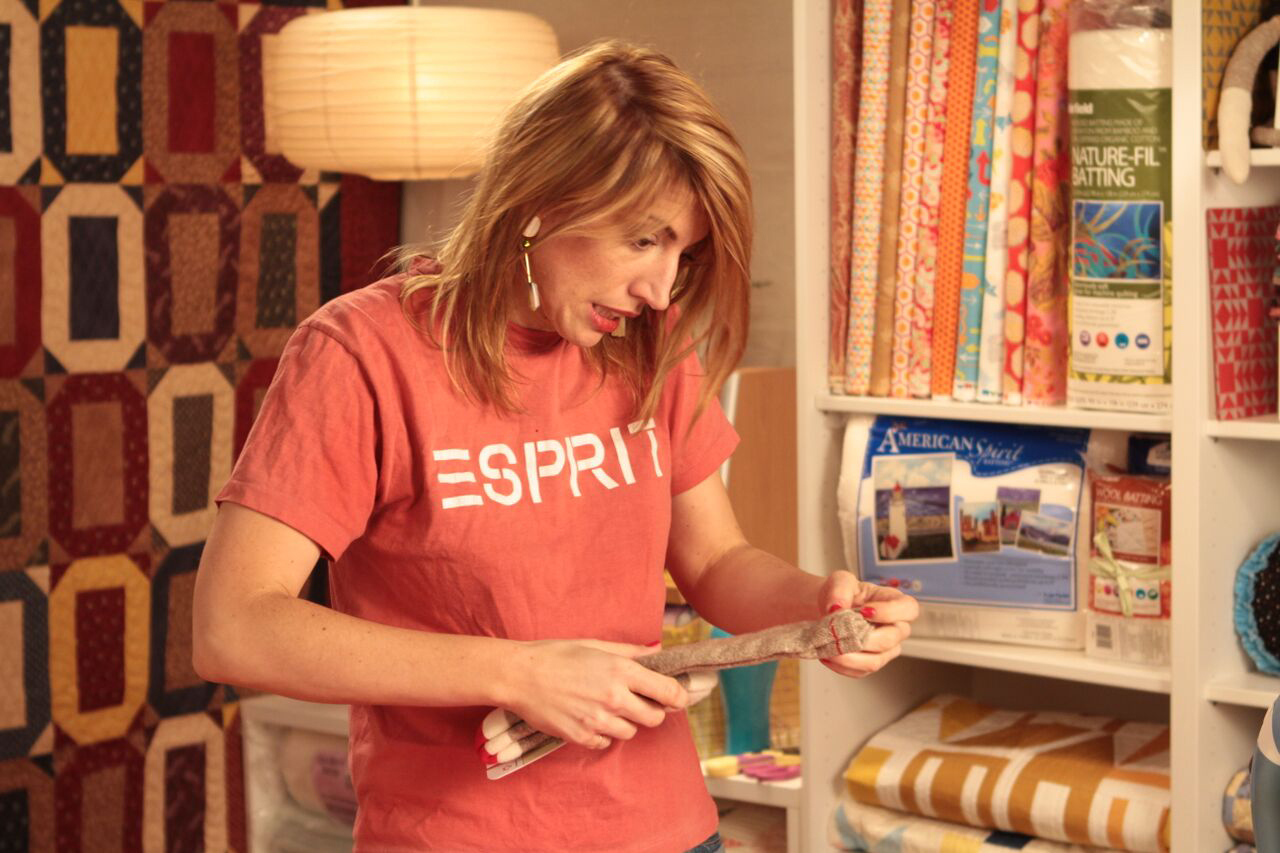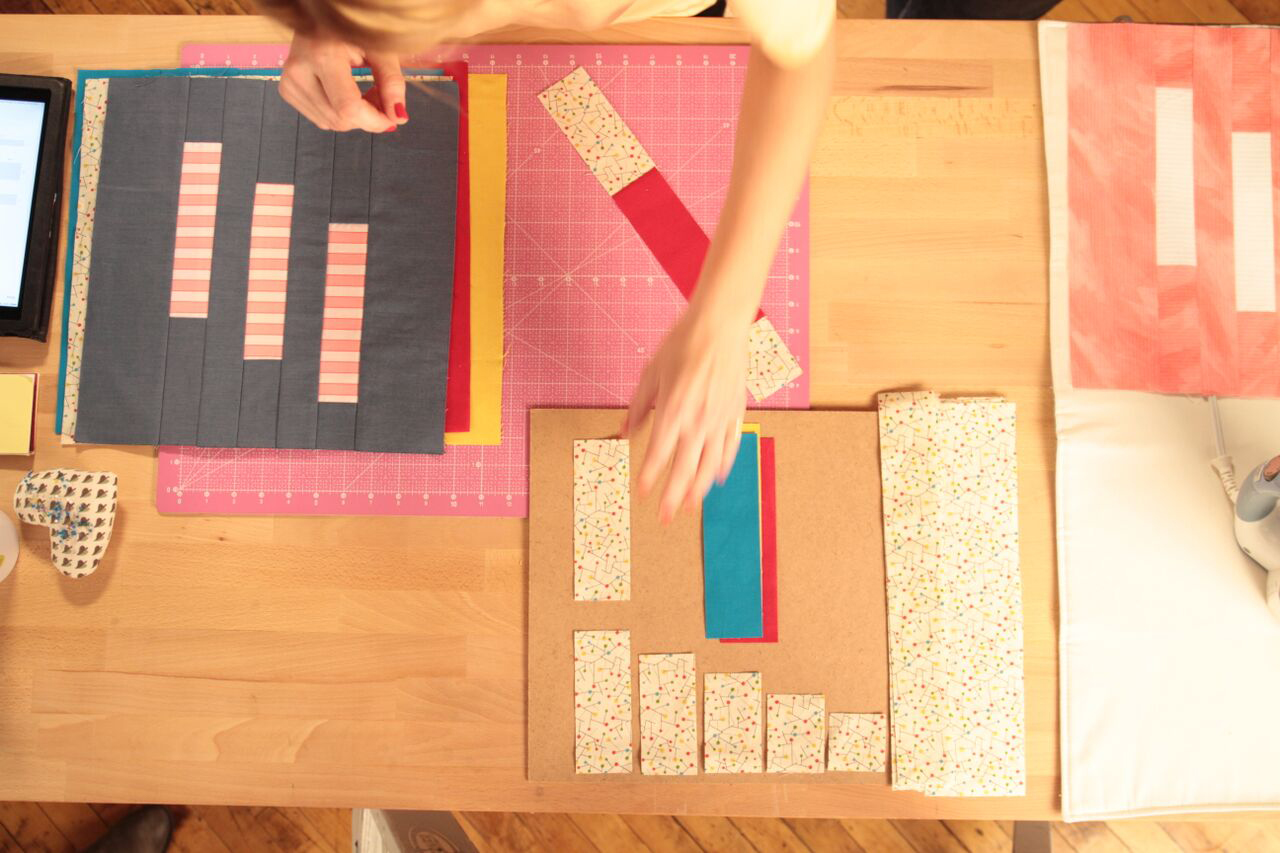
Me and guest Vicki. Tip: bring on guests who know more than you do.
Photo courtesy of Mary Fons
Indeed, I found out quickly that making a video tutorial is a snap.
But making a good video tutorial? That requires a tremendous amount of money, slavish dedication to quality, a team of people who know what they’re doing and, of course, the ability to actually know what you’re teaching. Laugh away, comrades, but I barely knew how to explain straight-of-grain and bias on my first “Quilty” episode. I’m sure the trolls have erected a castle in the comments section of that one.
For this article, I’m going to share what I know about filming tutorials on my own. However, for a bit of comparison, I’d first like to give you some detail about the other type of tutorial I film — PBS’ shows like “Love of Quilting.”
When we film “Love of Quilting” at Iowa Public Television we have a state-of-the-art television studio with four cameras (worth about $500,000), a big set, gigantic monitors and digital countdown clocks for the host. We have a sewing specialist who sews all patchwork. We have sponsors who give thousands of dollars to fund it all. There’s a control room where tape is being edited in real-time and shots are literally called by the floor director. It’s all being watched by the Fons & Porter editorial team to ensure we don’t say anything wrong, that we cover everything and that we nail the pacing — and, of course, to make sure no one has lipstick on her teeth (possibly the biggest job they have, as I consistently have problems with that).
If you’re creating your own videos at home or in a makeshift studio, you’re obviously not dealing with public television-scale of production, but you still need a director, stunt sewist, sponsor support and post-production wizard. It’s my firm belief that you need a production assistant as well — someone who can catch all the things you’ll inadvertently miss in your effort to essentially combine jazz hands with teaching complex skills on a power tool … while there are sharp things all over the table. Which brings us to your work as the on-camera talent!

You’re not a head of state, but this job ain’t for everyone. #stress
Photo courtesy of Mary Fons
Jazz Hands and Sharp Objects
I’ve been criticized for being on speed in my “Quilty” tutorials. I assure you I am not on speed — at least, not when I’m working. (Joking! Really!)
When I’m working, my default is energetic, which is what you need to be if you’re hosting video. First of all, a dull host is far less watchable. And then there are sponsors to consider. Sponsors who gave you money, fabric, etc., expect you to get eyeballs so they’ll make their money back and more. Never forget: sponsors may like you a lot, but their main objective is their bottom line. Really, you’re working for them. Deliver likes and orders, or they’ll use their money elsewhere. At “Quilty,” we needed at least six sponsors each year. One year, when ad budgets were tight, “Quilty” almost didn’t happen. An angel sponsor came in at the eleventh hour and we taped the episode. The lesson? Be peppy, get more viewers and make your sponsors happy.
As for you, specifically, my advice is this: know the material back and forth and move through the lesson in a timely fashion, but don’t cut corners or assume your viewer knows too much. The only way you will get this right is by doing it over and over. You’ll learn as you go. My work has gotten so much better over the years, and I owe it entirely to trial by fire.

Jack Newell, director; Matt Hyland, sound.
Photo courtesy of Mary Fons
Production Notes
In the beginning of the online tutorial era, a quilter could get away with a camera on a tripod behind her and some manual close-ups, as needed. “Editing” was just stopping the camera and starting it again. When I pitched “Quilty” in 2010, my first “must” was better production value. I knew that if a show didn’t look good, it wouldn’t be watched. Slick is expected and that’s true more than ever, now big-kahuna companies like Craftsy have elevated the expectations for viewers in terms of production quality.
For me, this meant guiding the budget (as best I could, since I wasn’t totally in charge of the budget) to pay as much as my parent company could afford to find the most talented crewmembers.
A good crew that eventually gets the process down to a science — an efficient, enjoyable science — is the key to making tutorials on your own. I cannot stress this enough. You can’t do everything yourself, you don’t want to, and this thing can actually be fun if you have people around who you know and trust.
Tips for Filming Your Own Tutorial Video
1.) Assemble and foster a great team. Pay them as much as you can.
2.) Know your material.
3.) Make whatever you’re making with jazz hands.
4.) Cover all the skills you advertise.
5.) Deliver on time.
6.) Ignore the haters.

Arranging step-outs for an episode of Quilty.
Photo courtesy of Mary Fons
God, it was hard in the beginning. We didn’t know how to do it. All we knew was what I brought from being on “Love of Quilting” a few times. To see what I mean, go watch “Quilty” from start to finish on QNNtv.com. If you want to do video, you can see the evolution of the job, right before your eyes. The first few episodes were rough. But I had a passion to teach beginners and what we lacked in process knowledge we made up for by being stoked about the project.
We produced 52 “Quilty” episodes each year and, by year three, we taped the entire year’s worth of shows in just six days — three days in the spring and three days in the fall.
Twenty-six episodes in three days, twice a year. That’s how good our ensemble got, how tight we ran that ship. It didn’t start that way, but that’s what a great team can do over time. And we were friends, so the work was eventually a blast.[1]
[1] The crew consisted of six people: me (host and editorial director), Rebecca (producer), Jack (director and camera one), Matt (sound), Gonzo (second camera) and Heather (production assistant, stunt sewist).

What a wonderful article. Thank you Mary. I never got the chance to meet you when I was at F+W but wish I had!
Great insight on producing quality tutorials. Thank you! (52 episodes in 6 days? WOW!)
Great post, Mary!
Thank you for this great article. It’s so helpful!
Great and informative article. Miss watching you on Quilty.
Thanks for the terrific insights, Mary – they’re not only relevant to filming tutorials (because really, on the whole, how many of us are actually going to do that?) but to life in general in these days of widespread social media compare-itis. Who among us does *not* feel inadequate in some way, on the daily? Thanks for shining a light on this and showing us how the magic really is made. Miss you lots in DC!
Hi Mary,
I’m in Australia and wonder if either of these shows are still available to watch via internet?
Thanks!
Lara
Still applies today!
I just finished a disastrous session of filming my first live tutorial on IGTV and I read this article with a keener understanding than I would have had yesterday. 🙂 Thank you so much for the tips!